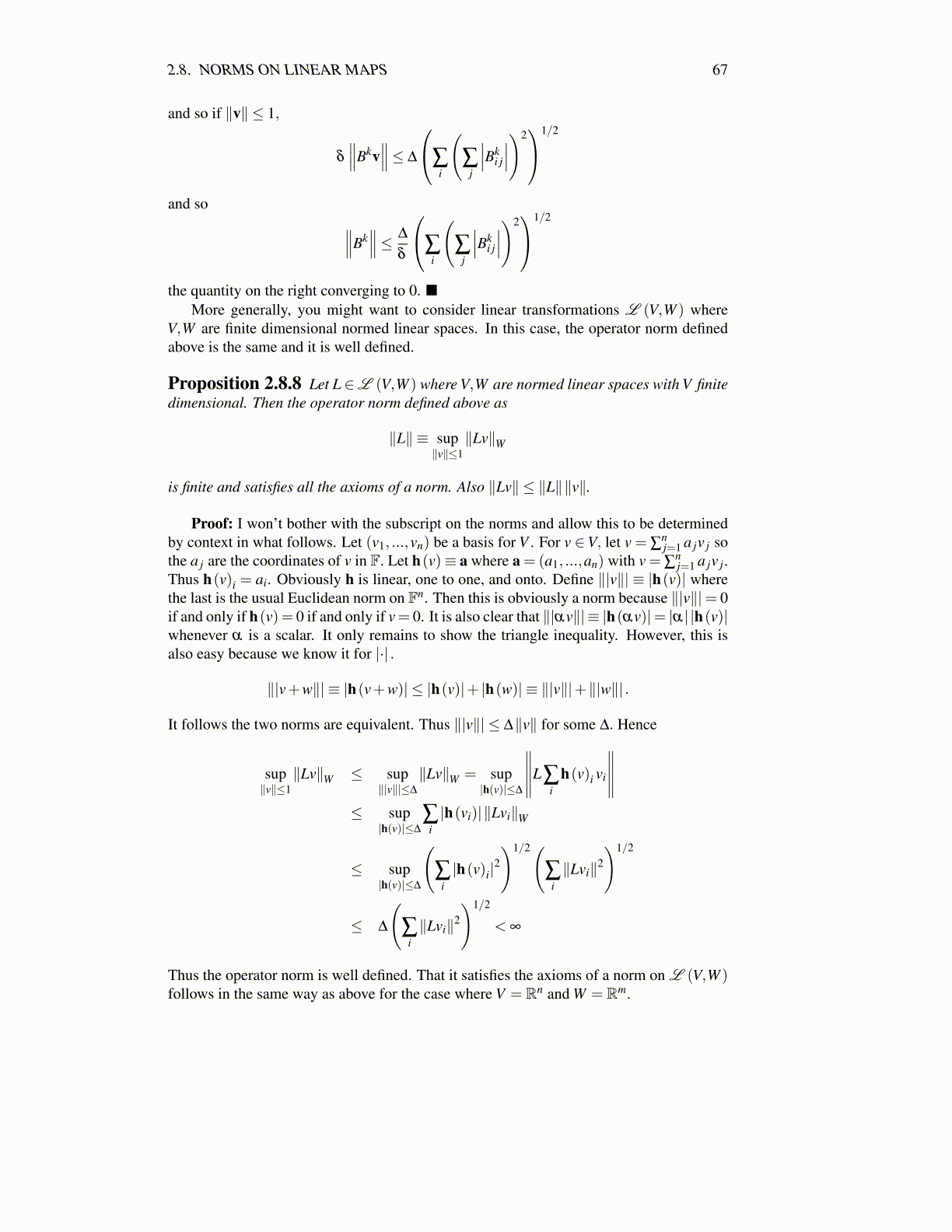
2.8. NORMS ON LINEAR MAPS 67
and so if ∥v∥ ≤ 1,
δ
∥∥∥Bkv∥∥∥≤ ∆
∑i
(∑
j
∣∣∣Bki j
∣∣∣)21/2
and so ∥∥∥Bk∥∥∥≤ ∆
δ
∑i
(∑
j
∣∣∣Bki j
∣∣∣)21/2
the quantity on the right converging to 0. ■More generally, you might want to consider linear transformations L (V,W ) where
V,W are finite dimensional normed linear spaces. In this case, the operator norm definedabove is the same and it is well defined.
Proposition 2.8.8 Let L ∈L (V,W ) where V,W are normed linear spaces with V finitedimensional. Then the operator norm defined above as
∥L∥ ≡ sup∥v∥≤1
∥Lv∥W
is finite and satisfies all the axioms of a norm. Also ∥Lv∥ ≤ ∥L∥∥v∥.
Proof: I won’t bother with the subscript on the norms and allow this to be determinedby context in what follows. Let (v1, ...,vn) be a basis for V . For v ∈V, let v = ∑
nj=1 a jv j so
the a j are the coordinates of v in F. Let h(v)≡ a where a = (a1, ...,an) with v = ∑nj=1 a jv j.
Thus h(v)i = ai. Obviously h is linear, one to one, and onto. Define ∥|v∥| ≡ |h(v)| wherethe last is the usual Euclidean norm on Fn. Then this is obviously a norm because ∥|v∥|= 0if and only if h(v) = 0 if and only if v= 0. It is also clear that ∥|αv∥| ≡ |h(αv)|= |α| |h(v)|whenever α is a scalar. It only remains to show the triangle inequality. However, this isalso easy because we know it for |·| .
∥|v+w∥| ≡ |h(v+w)| ≤ |h(v)|+ |h(w)| ≡ ∥|v∥|+∥|w∥| .
It follows the two norms are equivalent. Thus ∥|v∥| ≤ ∆∥v∥ for some ∆. Hence
sup∥v∥≤1
∥Lv∥W ≤ sup∥|v∥|≤∆
∥Lv∥W = sup|h(v)|≤∆
∥∥∥∥∥L∑i
h(v)i vi
∥∥∥∥∥≤ sup
|h(v)|≤∆
∑i|h(vi)|∥Lvi∥W
≤ sup|h(v)|≤∆
(∑
i|h(v)i|
2
)1/2(∑
i∥Lvi∥2
)1/2
≤ ∆
(∑
i∥Lvi∥2
)1/2
< ∞
Thus the operator norm is well defined. That it satisfies the axioms of a norm on L (V,W )follows in the same way as above for the case where V = Rn and W = Rm.